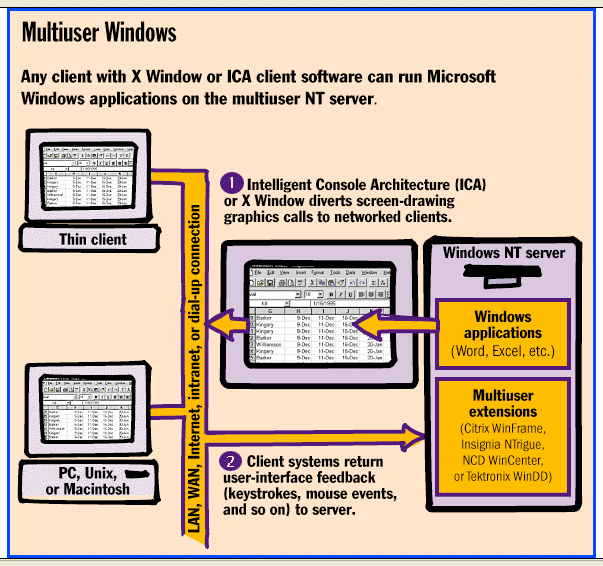| One company that's replacing Windows PCs with thin
clients is Reinicke (Bogart, GA), which specializes in
building pressed-board-lumber mills. With engineers
scattered throughout the Americas — "where the trees
are," explains Bobby Summerville, Reinicke's manager of
engineering services — he can't fly someone out every
time a PC has trouble. So, he's replacing the PCs with X
Window System-compatible NCs from HDS Network Systems. With 32 MB of RAM and a 17-inch color monitor, the HDS @workStation costs $1200 — not much less than a PC. But the big win for Summerville is support. If anything goes wrong, the user can plug in a new box: All software and data resides on the server. "It makes the computer more like a phone," says Summerville. "It looks like a computer, but it's really a graphics phone." Another engineering firm, Xtek (Cincinnati, OH), is also replacing PCs with X-compatible NCs. Xtek recently installed more than a dozen Network Computing Devices (NCD) machines connected to a pair of Silicon Graphics workstations and a dual-Pentium-90 NT server. Engineers use the NCs to run CAD programs on the workstations and Microsoft Office on the NT system. Pat Casey, Xtek's engineering systems administrator, says the NCs have won over his skeptical users and have eliminated the "hassles and problems" of PCs. "My management tasks are greatly reduced because I only have to upgrade the servers," he adds. "It's been great for me." Under the Hood Besides being NC early adopters, what do these two companies have in common? Underlying their thin clients is Citrix's WinFrame, which allows a network of client devices — of many hardware and OS types — to run programs on an NT server. The clients can be thin (under-$1000 graphics terminals, available from several vendors) or fat (ordinary PCs running the WinFrame client software). Users see a screen that's virtually indistinguishable from a PC running NT. They can launch 16- and 32-bit Windows programs, manipulate files, and do almost everything else a PC user can do. (See the figure.) It's startling to watch a $750 terminal or an ancient 286-based PC running the latest version of Word at Pentium speeds, but that's what WinFrame delivers. All the client device needs is the WinFrame client software, which is extremely lightweight. The DOS version requires only a 286, 1 MB of RAM, and a VGA card. Citrix and its sublicensees (including Insignia Solutions, NCD, and Tektronix) offer WinFrame client software for DOS, Win16, Win32, OS/2, 680x0-based Macs, PowerPC-based Macs, and many Unix versions. As a Netscape plug-in and ActiveX control, Citrix can run Windows programs in a Web browser. It's built into thin clients from Wyse and Boundless, and a Java version is on the way. In all, WinFrame brings Windows to nearly a dozen different CPU architectures. WinFrame is not an emulator; it's a client-neutral multiuser version of NT. Windows programs run natively at full speed on the server. The server also stores all the user's files and configuration data. When users log on, they get their own personalized Windows environment, just as they left it from their last session. WinFrame has two components: MultiWin, which adds multiuser capabilities to NT Server; and the Intelligent Console Architecture (ICA), a Citrix protocol that lets NT distribute graphics processing to networked clients. ICA intercepts calls to the Windows Graphical Device Interface (GDI) and redirects them to the client, which shows the graphics on the local screen. The server renders the text and bit-mapped graphics to save time and enhance security. (Text travels on the wire as rendered graphics, not data, to thwart network eavesdropping.) For 32-bit reentrant Windows programs, WinFrame needs to launch only one instance of the program to support multiple users. Otherwise, it must launch a separate instance for each user, which requires more server memory. Citrix recommends 4 to 8 MB per user. Depending on usage and applications, a Pentium or Pentium Pro server can typically handle 15 or more users. Application performance depends chiefly on the processing power of the server. The client machine's horsepower and the network's bandwidth are relatively minor factors. The ICA protocol is optimized for narrowband connections, requiring only 10 to 20 KB of bandwidth. It would take many ICA clients to bog down a typical 10-Mbps LAN. In fact, ICA even runs tolerably well over a 14.4- or 28.8-Kbps modem. Citrix's new version of ICA will take advantage of the greater bandwidth on LANs to deliver more performance. X Marks the Spot Sublicensees are extending WinFrame in all directions. For example, NCD's variation, WinCenter, converts ICA to X protocol. Insignia has a similar product, NTtrigue, and Tektronix has WinDD (short for Windows Distributed Desktop). They open up the world of Windows software to thin-client X terminals. Thin-client technology is not necessarily opposed to PCs — it has wider possibilities. XpressNet (Danville, CA) recently introduced a WinFrame-based toolkit for creating on-line training courses. The toolkit includes a modified version of WinFrame, ICA client software (the Netscape plug-in or ActiveX control), Microsoft's FrontPage, and course templates written in Hypertext Markup Language (HTML) and JavaScript. Companies can design their own custom training courses for Windows programs and deliver the lessons to users without installing the Windows programs on the users' PCs. The programs run remotely in a separate Web-browser frame, next to the lesson. It's another example of how this technology can expand options, not limit them. WinFrame's ability to deliver Windows over nearly any kind of network to almost any kind of client sounds eerily like the Java mantra. Although Microsoft is officially committed to PCs running their own copies of Windows and Windows applications, WinFrame adds a thin-client, multiplatform weapon to Microsoft's arsenal. It's not a true cross-platform solution, like Java is, and it's even more network-centric than the NCs from Oracle and Sun, but it's a useful alternative that only the stodgy would ignore. Multiuser Windows Citrix WinFrame adds multiuser extensions
for NT Server.
Copyright 1994-1998 BYTE |